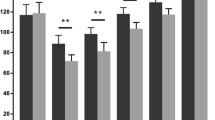Abstract
Introduction
To evaluate the clinical and radiographic results immediately after total knee arthroplasty, we compared the parapatellar and subvastus approach.
Materials and methods
Fifty-two patients with osteoarthritis were randomly assigned to two groups. The measurement was based on clinical and radiographic features.
Results
There was a significant difference in passive range of motion. Patients in the subvastus approach group revealed a full knee extension and flexion of 90° significantly earlier than those in the parapatellar group. However, on the day of discharge, both groups were comparable. Radiological assessment revealed analogous results in both groups. Correction of varus or valgus deformity was required in 48 patients.
Conclusion
Regardless of the surgical approach, the anteroposterior tibial femoral angle improved significantly in both groups. Concerning pain, operation time, blood loss, blood substitution and complications, no major differences could be seen.



Similar content being viewed by others
References
Bach CM, Steingruber IE, Peer S, Nogler M, Wimmer C, Ogon M (2001) Radiographic assessment in total knee arthroplasty. Clin Orthop 385:144–150
Bindelglass DF, Vince KG (1996) Patellar tilt and subluxation following subvastus and parapatellar approach in total knee arthroplasty. Implication for surgical technique. J Arthroplasty 11 [Suppl 5]:507–511
Chang CH, Chen KH, Yang RS, Liu TK (2002) Muscle torques in total knee arthroplasty with subvastus and parapatellar approaches. Clin Orthop 398:189–195
Cila E, Guzel V, Ozalay M, Tan J, Simsek SA, Kanatli U, Ozturk A (2002) Subvastus versus medial parapatellar approach in total knee arthroplasty. Arch Orthop Trauma Surg 122:65–68
Faure BT, Benjamin JB, Lindsey B, Volz RG, Schutte D (1993) Comparison of the subvastus and paramedian surgical approaches in bilateral knee arthroplasty. J Arthroplasty 8:511–516
Hanssen AD (2002) The subvastus approach for total knee arthroplasty resulted in better short-term outcomes than did the parapatellar approach. J Bone Joint Surg Am 84:325
Harvey IA, Barry K, Kirby SP, Johnson R, Elloy MA (1993) Factors affecting the range of movement of total knee arthroplasty. J Bone Joint Surg Br 75:950–955
Hofmann AA, Plaster RL, Murdock LE (1991) Subvastus (Southern) approach for primary total knee arthroplasty. Clin Orthop 269:70–77
Laubenthal KN, Smidt GL, Kettelkamp DB (1972) A quantitative analysis of knee motion during activities of daily living. Phys Ther 52:34–43
Matsueda M, Gustilo RB (2000) Subvastus and medial parapatellar approaches in total knee arthroplasty. Clin Orthop 371:161–168
Menke W, Schmitz B, Salm S (1992) Range of motion after total condylar knee arthroplasty. Arch Orthop Trauma Surg 111:280–281
Ranawat CS (1996) The patellofemoral joint in total condylar knee arthroplasty. Pros and cons based on five- to ten-year follow-up observations. Clin Orthop 205:93–99
Roysam GS, Oakley MJ (2001) Subvastus approach for total knee arthroplasty: a prospective, randomized, and observer-blinded trial. J Arthroplasty 16:454–457
Schurman DJ, Parker JN, Ornstein D (1985) Total condylar knee replacement. A study of factors influencing range of motion as late as two years after arthroplasty. J Bone Joint Surg Am 67:1006–1014
Author information
Authors and Affiliations
Corresponding author
Rights and permissions
About this article
Cite this article
Weinhardt, C., Barisic, M., Bergmann, E.G. et al. Early results of subvastus versus medial parapatellar approach in primary total knee arthroplasty. Arch Orthop Trauma Surg 124, 401–403 (2004). https://doi.org/10.1007/s00402-004-0692-3
Received:
Published:
Issue Date:
DOI: https://doi.org/10.1007/s00402-004-0692-3




